Irland |
|
|
|
| Übersicht – Contents: | |
Irland |
|
|
|
| Übersicht – Contents: | |
Flaggen – Flags: |
|
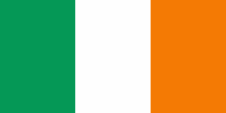 |
National-, Handels- und Marineflagge – national, merchant and naval flag, Seitenverhältnis – ratio = 1:2, Quelle/Source, nach/by: Wikipedia (D), Corel Draw 4 |
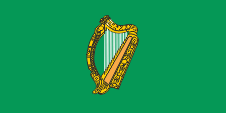 |
Gösch – jack, Seitenverhältnis – ratio = 1:2, Quelle/Source, nach/by: Flags of the World, Corel Draw 4 |
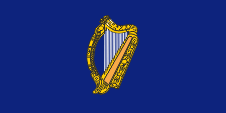 |
Flagge des Präsidenten – flag of the president, Seitenverhältnis – ratio = 1:2, Quelle/Source, nach/by: Flaggen und Wappen, Corel Draw 4 |
historische Flaggen – historical Flags: |
|
| offiziell – official: | |
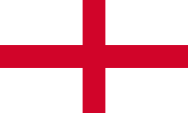 |
13. Jhd./cent.–1606, Flagge von England – flag of England, in Irland zu verwenden – to use in Ireland, Quelle/Source, nach/by: World Statesmen |
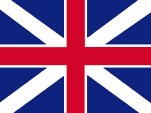 |
1606–1649, Flagge von England/Schottland – flag of England/Scotland, in Irland zu verwenden – to use in Ireland, Quelle/Source, nach/by: World Statesmen |
 |
1649–1660, Flagge von England – flag of England, in Irland zu verwenden – to use in Ireland, Quelle/Source, nach/by: World Statesmen |
 |
1660–1801, Flagge von England/Schottland – flag of England/Scotland, in Irland zu verwenden – to use in Ireland, Quelle/Source, nach/by: World Statesmen |
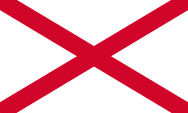 |
1783–1922, St.-Patricks-Flagge, geduldet – St. Patrick's Flag, tolerated, Quelle/Source, nach/by: Flags of the World |
 |
1801–1922, Flagge von Großbritannien – flag of United Kingdom, in Irland zu verwenden – to use in Ireland, Quelle/Source, nach/by: World Statesmen |
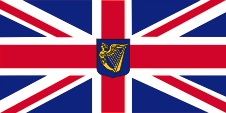 |
1848–1922, Flagge des Lord Lieutenant – Flag of the Lord Lieutenant, Quelle/Source, nach/by: World Statesmen |
|
|
|
| inoffiziell – unofficial | |
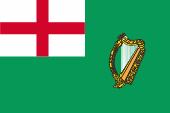 |
17.–18. Jhd./ cent., inoffizielle Handelsflagge – unofficial merchant flag, Quelle/Source, nach/by: Flags of the World |
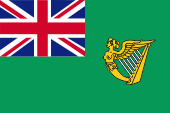 |
19. Jhd./cent.–1922, inoffizielle Handelsflagge – unofficial merchant flag, Quelle/Source, nach/by: Flags of the World |
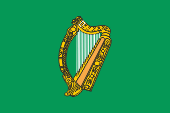 |
1798–1922, inoffizielle Nationalflagge – unofficial national flag, Quelle/Source, nach/by: Flags of the World |
 |
1848–1922, inoffizielle Nationalflagge – unofficial national flag, Quelle/Source, nach/by: Flags of the World |
Bedeutung/Ursprung der Flagge – Meaning/Origin of the Flag: |
|
| Die Flagge Irlands, Trikolore genannt, zeigt drei senkrechte Streifen in Grün, Weiß und Orange. Grün steht für die katholische Bevölkerungsmehrheit, Orange für die irischen Protestanten (in Erinnerung an Wilhelm III. von Oranien), Weiß für die Aussöhnung und den Frieden zwischen beiden Konfessionen. | The flag of Ireland, the "Tricolour", shows three vertical stripes in green, white and orange. Green stands for the catholic majority of the population, orange stands for the Irish Protestants (to remember William 3rd of Orange), white stands for reconciliation and peace between both religious denominations. |
| Die Gestaltung der Flagge geht auf die in den Revolutionsjahren von 1830 und 1848 häufig verwendete französische Trikolore zurück. Nicht nur in Irland diente sie als Vorlage für die Gestaltung der Nationalflagge. So wurde die irische Flagge im Revolutionsjahr 1848 von Thomas Francis Maegher nach Irland gebracht, seit 1908 zu Propagandazwecken verwendet, und wurde bei den nationalen Erhebungen des Jahres 1916 erstmals in Masse öffentlich gezeigt. | The designing of the flag has it's roots in the in the revolution's years from 1830 and 1848 frequently used French tricolor. Not only in Ireland it served as a pattern for the designing of the national flag. In this way the Irish flag was brought to Ireland by Thomas Francis Maegher in the revolution year 1848, used since 1908 for propaganda purpose, und was for the first time in use in large quantities at the national uprising in the year 1916. |
| Am 7. Januar 1922 wird Irland ein Freistaat (Dominion) und muss Nordirland (Ulster) an Großbritannien abtreten. Die Trikolore wird offiziell zur Landesflagge. | On 7 th of January in 1922, Ireland becomes a Free State (Dominion) and must cede Northern Ireland (Ulster) to United Kingdom. The tricolor officially becomes the flag of the country. |
| Als am 29.12.1937 die Republik Irland proklamiert wurde, wurde die Flagge als offizielles Staatssymbol bestätigt. Damit sollte auch die endgültige Trennung von England symbolisiert werden. | As the Republic of Ireland was proclaimed on 29th of December in 1937, this flag was confirmed as the official state's symbol. Therewith should be symbolized the irrevocable separation from England, too. |
| Grüne Flaggen als irisches Symbol wurden schon im 17. Jahrhundert zur See verwendet. Sie zeigten im fliegenden Ende die Brian-Boru-Harfe, ein historisches, irisches Instrument aus dem 14. Jahrhundert und in der Oberecke die Heraldik Englands bzw. später auch Großbritanniens. Offiziell waren diese Flaggen nicht, maximal geduldet, denn Irland gehörte zu England bzw. Großbritannien und hatte, wie andere Landesteile auch, offiziell dessen Flaggen zu führen. Vielfach wurde in Aufständen versucht die englisch-britische Herrschaft abzuschütteln. Oft spielten dabei einfarbige grüne Flaggen mit Aufschriften oder mit der Brian-Boru-Harfe in der Mitte eine große Rolle. Ab 1782 gab es ein irisches Parlament und als Landessymbol wurde das Stankt-Patricks-Kreuz eingeführt, das ab 1801 auf der Flagge Großbritanniens erschien. Entsprechende Flaggen fanden jedoch nur zum Teil Anerkennung in der irischen Bevölkerung, sind jedoch bis heute zu sehen, wenn auch sehr selten. Die grüne Harfen-Flagge setzte sich im Aufstand von 1798 als Nationalsymbol endgültig durch. Sie galt, neben der seit 1848 verwendeten heutigen Trikolore, bis 1922 als inoffizielle Nationalflagge. Heute ist die grüne Harfen-Flagge die Gösch Irlands. Die Farben der Flagge sind wie folgt definiert: Orange = Pantone 151; Grün = Pantone 347. |
Green flags as an Irish symbol have been used
at sea since the 17th century. They showed in the flying end of the flag the Brian Boru harp, a historic, Irish instrument from the 14th century and in the upper
canton, the heraldry of England and later of United Kingdom. Officially these flags were not,
maximally tolerated, because Ireland belonged to England or United Kingdom and had, like other parts of the country, officially
to use its flags. Many attempts have been made in rebellions to overthrew the Anglo-British rule. Monochrome green flags with inscriptions or the Brian Boru harp in the middle often played a big role. From 1782 there was an Irish parliament and as a symbol of the country was introduced the Saint Patrick's Cross, which appeared from 1801 in the flag of United Kingdom. However, these flags were only partially recognized by the Irish people but can still be seen until today, albeit very rarely. The green harp flag prevailed in the uprising of 1798 as a national symbol finally. It was, in addition to the current tricolor used since 1848, an unofficial national flag until 1922. Today, the green harp flag is the naval jack of Ireland. The colors of the flag are defined as follows: orange = Pantone 151; green = Pantone 347. |
| Die Standarte des Präsidenten zeigt das Bild des Wappens von Irland, die goldene Harfe auf blauem Grund. | The president's standard shows the image of the coat of arms of Ireland, the golden harp on a blue background. |
| Quelle/Source: nach/by: Wikipedia (D), Die Welt der Flaggen, Flaggen und Wappen der Welt, Flags of the World | |
Wappen – Coat of Arms: |
|
 |
Wappen Irlands – coat of arms of Ireland, Quelle/Source: Corel Draw 4 |
Bedeutung/Ursprung des Wappens – Meaning/Origin of the Coat of Arms: |
|
| Das Staatswappen zeigt eine goldene Harfe mit silbernen Saiten auf blauem Schild. Es ist die Brian-Boru-Harfe, ein historisches, irisches Instrument aus dem 14. Jahrhundert und ist schon seit dem Mittelalter als Symbol Irlands bekannt. Sie steht heute im Trinity College in Dublin. | The coat
of arms showa a golden harp with silvery strings on a blue blazon.
This is the Brian Boru harp, a historic, Irish instrument from the 14th century and has been known since the Middle Ages as a symbol of Ireland.
It is kept now at Trinity College in Dublin. |
| Quelle/Source, nach/by: Flaggen Wappen Hymnen | |
Flugzeugkokarde – aircraft roundel: |
|
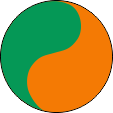 |
1939–1954, Flugzeugkokarde – aircraft roundel Quelle/Source, nach/by: Wikipedia (EN) |
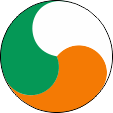 |
seit/since 1954, Flugzeugkokarde – aircraft roundel Quelle/Source: nach/by Wikipedia (EN) |
Landkarten – Maps: |
Lage – Position: |
Landkarte des Landes – Map of the Country: |
Zahlen und Fakten – Numbers and Facts: |
|
|
|
|
|
|
|
|
|
|
|
|
|
|
|
|
|
|
|
|
Geschichte: |
| 10.000 v.Chr. · erste Besiedelung Irlands 500 v.Chr. · Einwanderung keltischer Stämme seit 430 n.Chr. · Ausbreitung des Christentums ca. 500 · Herausbildung von fünf Stammeskönigreichen (Ulster, Munster, Connaught, Leinster, Meath) 795–1014 · Einfälle der Vikinger ca. 1000 · Brian Boru vereinigt die Stammeskönigreiche 1169 · beginnende Eroberung von Irland durch das Königreich England 1171 · Irland wird englisches Lehen 1297 · Einrichtung eines ersten irischen Parlaments, die Eroberung von Irland durch das Königreich England ist im Prinzip abgeschlossen 1541 · der englische König lässt sich zum König von Irland proklamieren, in Folge starker irischer Widerstand 1601 · Schlacht bei Kinsale – Sieg Englands über die irischen Aufständischen 1641 · großer Aufstand der Iren 1649 · Cromwells Blutbad in Drogheda, der irische Widerstand wird gebrochen, in Folge starke irische Auswanderung 1782 · Einrichtung eines irischen Parlaments 1798 · weiterer großer irischer Aufstand 1801 · Irland wird mit Großbritannien zum Vereinigten Königreich Großbritannien und Irland verbunden 1845–1855 · wegen Hungers wanden Massen von Iren in die USA aus 1916 · großer bewaffneter Aufstand der Iren 1919–1921 · Englisch-Irischer Krieg 07.01.1922 · Irland muss Nordirland (Ulster) an England abtreten und wird Freistaat (Dominion) 29.12.1937 · Proklamation der Republik Irland innerhalb des British Commonwealth of Nations, somit volle Souveränität 1945 · Großbritannien erkennt die Republik Irland an 18.04.1949 · Irland verlässt den Commonwealth 1973 · Beitritt zur EG 1998 · „Good Friday“-Vertrag zur Regelung der Nordirland-Frage |
History: |
| 10.000 B.C. · first settlement in Ireland 500 B.C. · immigration of Celtic tribes since 430 A.D. · expansion of the Christianity ca. 500 · arising of five tribal kingdoms (Ulster, Munster, Connaught, Leinster, Meath) 795–1014 · invasions of the Vikings ca. 1000 · Brian Boru unites the tribal kingdoms 1169 · beginning of the conquest of Ireland by the Kingdom of England 1171 · Ireland becomes an English fiefdom 1297 · establishment of a first Irish Parliament, the conquest of Ireland by the Kingdom of England is essentially complete 1541 · the English king lets proclaim itself to the king of Ireland, in result powerful Irish resistance 1601 · battle near Kinsale – England triumphs over the Irish insurgents 1641 · great rebellion of the Irishmen 1649 · Cromwell's massacre in Drogheda, the Irish resistance gets broken, in result potent Irish exodus 1782 · installation of an Irish parliament 1798 · further great Irish rebellion 1801 · Ireland gets united with United Kingdom to the Unitded Kingdom of Great Britain and Ireland 1845–1855 · because of hunger exodus of Irish in masses into the USA 1916 · great armed insurrection of the Irishmen 1919–1921 · English-Irish war 7th of January in 1922 · Ireland has to cede Northern Ireland (Ulster) to England and Ireland becomes a Free Staat (Dominion) 29th of December in 1937 · proclamation of the Republic of Ireland within the British Commonwealth of Nations, therewith full sovereignty 1945 · United Kingdom recognizes the Republic of Ireland 18th of April in 1949 · Ireland leaves the Commonwealth 1973 · joining to the European Community 1998 · „Good Friday“-agreement for regulation of the Northern Ireland question |
| Quelle/Source: Atlas zur Geschichte, World Statesmen, Wikipedia (D), Weltgeschichte |
Ursprung des Landesnamens – Origin of the Country's Name: |
|
| Der Name "Irland" enthält das alte irische bzw. indoarische Wort "ir", was Westen heißt. Irland ist das "Westland". Westen ist auf Irisch heute "Siar". | The name "Ireland" contains the old Irish rspectively Indo-Aryan word "ir", which means west. Ireland is the "Westland". West is in Irish today "Siar". |
| Quelle/Source: Atlas der wahren Namen | |